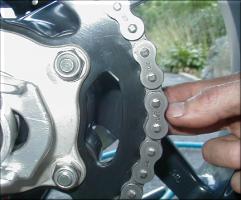
If the o-rings are kept in good shape and the chain is not allowed to rust, it will likely end its long life because it has stretched too much. This is due to wear in the pins, not because the side plates are weak. The Falco has no chain stretch indicators on its swingarm, not that they would be valid if you swapped your gearing as many people do. So, periodically, you should check its stretch by measuring it.
The quick rule of thumb for measuring chain wear is to grab the chain at back of the sprocket behind the rear axle, and pull it off the sprocket. With a worn chain, you will be able to pull the chain away. The rule-of-thumb says that if you can see half a tooth on the sprocket, the chain is dangerously worn and should be replaced. This is an old check, though, and may be for a non o-ring chain. Nevertheless, its a handy way to check for excessive wear when you're looking at buying a used bike.
| After 12,000 miles, this Falco chain can hardly be pulled away from the sprocket at all. When half a tooth can be exposed, its time for a new chain. |

|
In order to accurately measure chain stretch, first tension the chain. If the chain is on the bike, you can hang 20 lb from the lower span of the chain with the bike in neutral and the rear wheel raised. Now measure a length of chain, along the top, preferably from center of pin to center of pin, across as many pins as possible. Measuring 10 to 20 pins is desireable, but in this case I used a 6-inch caliper so I was only able to measure four links (8 pins). Rotate the wheel a bit and repeat this measurement in at least two more locations.
Average your measurements to remove manufacturing tolerances and measurement inaccuracies. Now, to compare against the standard, you need to divide your measurement by the number of pins that were measured. There are two pins in each link, so if you measured from a rivet to another point 5 links away, divide your measurement by 5. Now compare this value to the standard value for a "525" chain: 0.625 inches (15.9 mm) per link (the leading "5" means the pitch is 5/8ths of an inch). If the chain has stretched more than 1% (greater than 0.631 inches or 16.0 mm per link), it should be replaced. If for some reason you are running a non o-ring chain, wear of 2% is the allowed.
| Measurement 1 | 5.028 in |
| Measurement 2 | 5.032 in |
| Measurement 3 | 5.030 in |
| Average of three measurements = | 5.030 in |
| Divide by 8 pins measured = | 0.629 in |
| Subtract standard value 0.625 in = | 0.004 in |
| Divide by standard value 0.625 in = | 0.0064 |
| Multiply by 100% = | 0.64 % |
| Answer above less than 1% | Yes, chain is OK |
At 12,000 miles, this chain was still OK, but on its way out.
See the chain at end of life.
Or go back to the Falco home page.